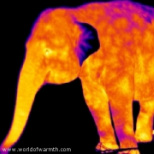Elephants in Time
- Looking back on their evolutionary history gives us an idea of where some of their important physiological traits arose from. Elephants are categorized under Proboscides (order) although there were initially over 352 species now only two remain the African and Asian elephant. Elephants are keystone species in many ecosystems today. Unfortunately, they are largely hunted for their husks. The elephant is a complex mammal with certain physiological processes crucial to its survival.

- Elephants are typically found in sub-Saharan Africa, South Asia and Southeast Asia in a variety of climates including savannas, forests, deserts and marshes. They tend to stay close to water and mainly feed on grass and leaves since they are herbivores. Female elephants travel in families where as male elephants tend to leave the group at a young age and either live alone or sometimes with other male elephants. They communicate through touch, sight, smell and sounds.

Blood in Elephants
Important features in elephants to Note:
A-Typical Heart Features:
Important features in elephants to Note:
- One of the largest mammals, elephants have very large organs to support its large size but proportionally compared to humans and other animals are not any bigger. The heart beats about 30 times per minute weighing approximately 12 to 21 kg depending on the age of the elephant. The amount of blood in an elephant is approximately 10% of its body weight.
- The large blood volume of elephants can increase the resistance to blood flow. Yet there are factors that help to negate these effects such as an increase in the flexibility of the eurethrocytes.
A-Typical Heart Features:
- Most mammals including humans have a single pointed (heart-shaped) heart but elephants have a double apex at the bottom of the heart. Because these mammal have a much slower heart rate than humans, they have a much higher blood pressure. This slow heart rate is related to the large size of the heart. The heart is able to pump a lot more blood per beat (larger stroke volume) but it also takes longer to move through the heart therefore resulting in a less beats per minute.

Staying Cool
- Through understanding the climates elephants are typically found one can gather how important blood regulation is in these large mammals.The large ears are a very important cooling mechanism for the blood of elephants-they are about one sixth the size of the elephant. Very small blood vessel in the ears cool the warm blood circulating through the ears because of the thin layer of skin that separates the blood from the outside, its is approximately 0.04-0.08 inches thick. Approximately 12 liters of blood flow through their ears per minute and the elephant's body temperature can be reduced by 3 degrees. Because elephants do not sweat these cooling mechanisms are vital to maintain homeostatic conditions in the elephant.
